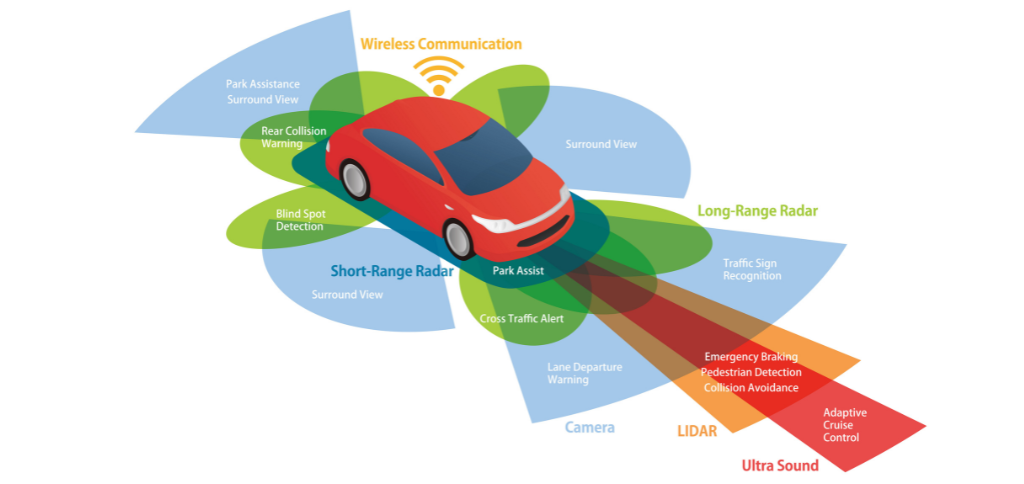10 mins read
With the roll out of GSR2 in July of this year, Advanced Driver Assistance Systems (ADAS) in vehicles will be set to ‘Always On’ in vehicles. Previously ADAS were optional systems, with many drivers often choosing to manually turn them off. With significantly higher volumes of traffic on Irish roads post-Covid, and the worryingly upward trend of fatal collisions, ADAS has a key role to play in helping to protect drivers and make our roads safer.
What is ADAS?
ADAS, or Advanced Driver Assistance Systems, are a group of sensors, software and systems designed to aid the driver in safe operation of a modern vehicle. ADAS is classified as Level 2 Automation and is designed to provide a safety net and warnings to the driver, while they maintain full awareness and control of the vehicle.

ADAS systems can be simplified into 4 distinct categories:
- Forward Emergency Braking: The vehicle uses radar and lidar to monitor traffic, pedestrians and obstacles in the vehicles path and react to hazards faster than a human.
- Blind Spot Monitoring: The vehicle uses radar and lidar to monitor the driver’s blind spots. Driver’s will note a small warning light in their wing mirrors to alert them to a vehicle to rear quarters of their own vehicle. If a driver indicates to move lane, the system to give an audible warning and may keep the steering wheel in a straight-ahead position until it is safe to move.
- Lane Departure Warning: The vehicle will use live video to monitor road markings, road signs and will use radar and lidar to monitor traffic. If the driver begins to drift, the system will steer the vehicle back in lane and give a warning to the driver. If the driver wishes to change lane, the indicator must first be used.
- Adaptive Cruise Control: The driver will set a maximum speed, the vehicle will then use radar, lidar and live video to maintain a safe distance from the vehicle ahead and will speed up and slow down as required. In this case, the driver must maintain control of the steering wheel.
Why has ADAS been developed?
ADAS was developed in effort to reduce the number of Road Traffic Accidents caused by human error, and to reduce the number of injuries and fatalities caused by such events.
The RSA conducted research on fatal road collision between 2008 – 2012, a period in which 1,077 people lost their lives in 983 collisions. Of the 867 cases examined, 121, or 14%, were caused by mechanical defects. This leaves 713, or 86% of accidents which may have been negated by the use of advanced monitoring systems, had they been available and in use at the time of the accident.

Image Source: RSA Fatal Collisions 2008-2012 Report, Published 4th April 2016
Who can benefit from ADAS?
The European Commission for Road Safety recognises significant benefits to older drivers and those with limited neck mobility. They surmise that drivers can benefit for assistance in merging and lane changing, earlier detection of road signage and aid in reaction to complex traffic situations.
True as this is, every driver with an ADAS vehicle can find improvements in their driving safety and experience when ADAS is turned on and trusted. If you are someone who relies on the car for work, spends a lot of time driving between meetings and taking calls in the car, ADAS can provide an additional layer of safety while you may be distracted.
Anecdotally, I am a male driver in my mid 30’s and I have the full-time use of two vehicles, one with and one without ADAS. While ADAS is no replacement for experience, awareness and respect to other road users, I will always choose the vehicle with ADAS when I can, especially on longer motorway journeys where adaptive cruise control, lane control and emergency braking are most effective.
Positives:
As ADAS is in its relative infancy, hard data on the effectiveness is not confirmed, however, initially research from University of Limerick suggests widespread uptake of ADAS could reduce accidents by roughly 25%.
It is stated on SFI.ie (Scientific Foundation Ireland):
Dr Barry Sheehan of Lero at UL said: “Our research suggests that introducing ADAS across all vehicles would lower the number of road crashes by almost one quarter (23.8%). Furthermore, accidents happening in the two most frequent contexts can be reduced by 29%.
We expect to see these assumptions and early findings confirmed in the coming years, and perhaps surpassed as ADAS advances and improves.
Negatives:
Some drivers reported that early ADAS technology was intrusive or bothersome, and this is to be expected with the roll out of any new technology to an end user.
Early radars were prone to malfunction in wet conditions, or if a significant build up of dirt was present, but these issues have largely been improved or completely eradicated.
Drivers also reported issues with the lane departure systems impeding them from changing lanes without use of their indicator, but this should not be a major consideration, and ADAS is no replacement for traffic laws and common courtesy, and indication should always happen before a manoeuvre.
Conclusion and Recommendation:
ADAS has been here for some time, and the majority of users have reported positively on its effectiveness. Regardless, the EU and worldwide counterparts are in agreement that it is here to stay. With the roll out of GSR2, these systems will be set to ‘Always On’, so regardless of an individual’s stance on ADAS, they will need to embrace the technology.
Personally, I have never deactivated ADAS on my own car, nor will I, as I value the additional safety shield it offers to me, my family, and my fellow road users.
